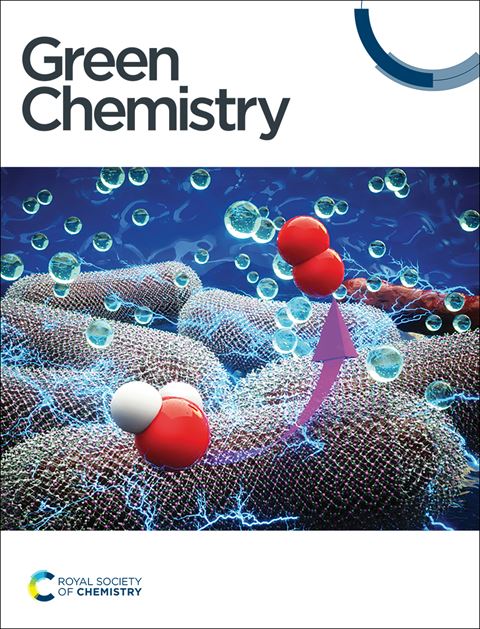Electrochemical hydrogenation of nitrogen to ammonia under ambient conditions in a suspended dual-catalyst system†
IF 9.3
1区 化学
Q1 CHEMISTRY, MULTIDISCIPLINARY
引用次数: 0
Abstract
Electrocatalytic hydrogenation provides a sustainable method and green route to convert atmospheric nitrogen N2 into ammonia NH3 under mild conditions but is still challenged with the issues of low working current density and low faradaic efficiency. Herein, a suspended electrocatalytic dual-catalyst system was designed to realize the nitrogen hydrogenation into ammonia with high faradaic efficiency and high working current density, which is often thought to be rather difficult in aqueous electrolysis. The electrochemical system uses a soluble polyoxometalate of silicotungstic acid as an electron captor and a suspended noble-metal catalyst Ru/TiO2 as the nitrogen fixation catalyst, so that the catalyst particles can be detached from the electrode, which is quite different from common electrochemical systems. Because the nitrogen fixation catalyst is free from the electrode, no current flows through the catalyst and even a non-conductive catalyst can be used, so that the suspended electrochemical system can provide a rather large opportunity and maneuverability for enhancing the nitrogen fixation process.

电催化加氢为在温和条件下将大气中的氮气 N2 转化为氨气 NH3 提供了一种可持续的方法和绿色途径,但仍面临着工作电流密度低和远动效率低的挑战。在此,我们设计了一种悬浮电催化双催化剂系统,以实现高远达效率和高工作电流密度的氮氢化为氨,而这通常被认为在水电解中相当困难。该电化学系统以可溶性硅钨酸多氧甲基盐作为电子俘获剂,以悬浮贵金属催化剂 Ru/TiO2 作为固氮催化剂,因此催化剂颗粒可以从电极上脱离,这与常见的电化学系统有很大不同。由于固氮催化剂脱离了电极,没有电流流过催化剂,甚至可以使用不导电的催化剂,因此悬浮电化学系统可以为提高固氮过程提供相当大的机会和可操作性。
本文章由计算机程序翻译,如有差异,请以英文原文为准。
求助全文
约1分钟内获得全文
求助全文
来源期刊

Green Chemistry
化学-化学综合
CiteScore
16.10
自引率
7.10%
发文量
677
审稿时长
1.4 months
期刊介绍:
Green Chemistry is a journal that provides a unique forum for the publication of innovative research on the development of alternative green and sustainable technologies. The scope of Green Chemistry is based on the definition proposed by Anastas and Warner (Green Chemistry: Theory and Practice, P T Anastas and J C Warner, Oxford University Press, Oxford, 1998), which defines green chemistry as the utilisation of a set of principles that reduces or eliminates the use or generation of hazardous substances in the design, manufacture and application of chemical products. Green Chemistry aims to reduce the environmental impact of the chemical enterprise by developing a technology base that is inherently non-toxic to living things and the environment. The journal welcomes submissions on all aspects of research relating to this endeavor and publishes original and significant cutting-edge research that is likely to be of wide general appeal. For a work to be published, it must present a significant advance in green chemistry, including a comparison with existing methods and a demonstration of advantages over those methods.
 求助内容:
求助内容: 应助结果提醒方式:
应助结果提醒方式:


